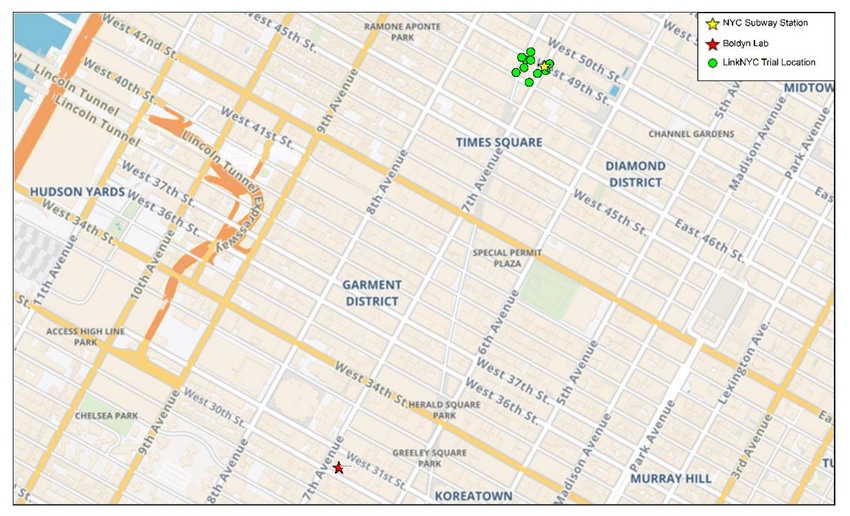Boldyn to test Artemis' wireless tech in NYC on Dish's spectrum
Boldyn Networks is looking to test wireless technology from startup Artemis Networks using Dish Network spectrum on some of its LinkNYC transmission towers in New York City.

Boldyn Networks is seeking FCC permission to test wireless technology from startup Artemis Networks. The tests appear to leverage some of the LinkNYC 5G transmission towers that Boldyn operates in New York City in conjunction with CityBridge and Intersection.
"We appreciate your interest regarding our Link platform in NYC, which provides critical mobile connectivity to millions of people," Boldyn wrote in response to questions from Light Reading about the company's new FCC filing. "As you know, one of the goals of the public-private program is to improve mobile connectivity equitably across New York, which means providing access to all carriers. While we cannot comment on specific customer engagements, we are focused on working with partners to expand access to connectivity across the five boroughs."
In Boldyn's request to the FCC, the company wrote that it intends to "conduct trials in the 3.5GHz spectrum that will examine a new digital modulation technique for wireless networks, thereby providing important information for the development of next generation wireless communications applications for the business and consumer markets."
The company's filing also lists roughly half a dozen locations where it will conduct the tests, including on LinkNYC kiosk locations.
The company also notes that it received permission from Dish Network to use the company's 3.5GHz CBRS spectrum holdings for the tests. That's not a surprise considering Dish's spectrum has routinely been used for Artemis tests.
The return of Artemis' pCell
Roughly a year ago, Artemis made a loud, public announcement after over five years of silence. At the time, the company touted a partnership with Federated Wireless, a real-world deployment at the SAP Center sports stadium in San Jose, California, and high-profile support from former Apple CEO John Sculley and financial analyst Craig Moffett, of MoffettNathanson.
The company also said its pCell 5G virtualized Radio Access Network (vRAN) technology could deliver 10 times the capacity of conventional networks in the same amount of spectrum. "While existing LTE/5G networks average less than 100 Mbit/s in 20MHz of spectrum, a network powered by pCell with equivalent spectrum averages over 1 Gigabit/second, and over 7.5 Gigabits/second in 150MHz, faster than any mobile network in the world," the company wrote last year.
Shortly after that announcement, Light Reading reported that Artemis asked the FCC for permission to test an LTE wireless network using its pCell technology – and Dish's spectrum – in an event center in San Bernardino, California.
However, the company has not made any other public announcements since last year.
Artemis is one of a handful of startups touting game-changing wireless technologies. Others include XCOM Labs and Cohere Technologies.
Artemis first made a splash in 2015 with claims that its pCell technology would make 5G irrelevant.
Boldyn's latest gambit in NYC
In the US, Boldyn is the new corporate amalgamation of BAI Communications, ZenFi, Mobilitie, Signal Point Systems and Transit Wireless. The company inherited the LinkNYC business when it acquired ZenFi.
 New LinkNYC kiosks can support 5G equipment.
New LinkNYC kiosks can support 5G equipment.
(Source: LinkNYC. Used with permission.)
LinkNYC started in 2014 as an effort to install around 7,500 10-foot-tall Wi-Fi kiosks – in place of pay phones – around New York City, in order to provide free Internet services to residents. However, the companies involved in the effort failed to reach some of their initial construction targets: For example, city officials reported in 2020 that there were only about 1,800 of the required 3,153 kiosks in place.
Nonetheless, LinkNYC officials have boasted that the city-wide network has more than 13 million Wi-Fi users and has connected more than 25 million free phone calls.
More recently, the city amended its agreement with LinkNYC to pave the way for bigger kiosks – ones standing 32 feet tall – that could support 5G as well as Wi-Fi. However, the 5G service is intended to support the nation's big 5G wireless providers, and the kiosks' 5G connections are not free like the Wi-Fi ones.
The installation of those bigger, 5G-capable kiosks started last year, but in recent months they've come under fire over historic preservation and environmental review requirements.
Related posts:
— Mike Dano, Editorial Director, 5G & Mobile Strategies, Light Reading | @mikeddano
About the Author(s)
You May Also Like




_International_Software_Products.jpeg?width=300&auto=webp&quality=80&disable=upscale)







